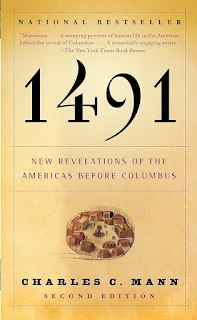 |
| 1491- New Revelations of the Americas Before Columbus |
DESCRIPTION:
"1491: New Revelations of
the Americas Before Columbus" is a groundbreaking work by journalist and
author Charles C. Mann, published in 2005. The book challenges traditional
perceptions of pre-Columbian America, presenting a compelling narrative that
reshapes our understanding of the indigenous cultures that thrived in the
Americas before the arrival of Christopher Columbus in 1492. With meticulous
research and engaging storytelling, Mann provides a comprehensive exploration
of the diverse civilizations, advanced societies, and ecological complexities
that characterized the Americas prior to European contact.
One of the central themes in
"1491" is the sheer complexity and sophistication of indigenous
civilizations. The prevailing narrative about the Americas before Columbus
often portrayed the region as sparsely populated, inhabited by scattered, primitive
societies. Mann, however, challenges this notion, presenting evidence of
vibrant and densely populated civilizations that rivaled, and in some cases
surpassed, their European counterparts.
Mann explores the vast and
intricate societies that existed across the Americas, from the expansive
empires of the Aztecs and the Inca to the mound-building cultures of North
America and the Amazonian civilizations. He dispels the myth of the "Noble
Savage" by showcasing the sophistication of indigenous cultures, their
intricate social structures, advanced agricultural practices, and monumental
architectural achievements. The book invites readers to appreciate the
diversity and complexity of these societies, emphasizing that they were not
mere outliers but integral components of the global tapestry of human
civilization.
One of the key revelations in
"1491" is the staggering population estimates of pre-Columbian
America. Mann challenges the widely accepted idea of a sparsely populated
"virgin land" by presenting evidence that the Americas were home to
tens of millions of people before Columbus. He delves into the works of
historians, archaeologists, and anthropologists, highlighting how factors such
as advanced agricultural techniques, complex trade networks, and urban centers
contributed to the thriving populations of indigenous civilizations. This new
perspective on the scale of pre-Columbian societies fundamentally alters our
understanding of the impact of European diseases on native populations.
The author also delves into
the ecological impact of indigenous societies on the Americas. Rather than
viewing Native Americans as passive stewards of the land, Mann explores how
they actively shaped and managed their environments. The concept of "the
pristine wilderness" is challenged as the book reveals the intricate ways
in which indigenous people engaged with and modified their landscapes. The use
of controlled burns for agricultural purposes, the creation of elaborate canal
systems, and the cultivation of diverse plant varieties are just a few examples
of the sophisticated environmental practices employed by pre-Columbian
societies.
"1491" also
addresses the transformative impact of the Columbian Exchange, the vast
biological and cultural interchange that occurred after Columbus's voyages.
While the exchange is often associated with the introduction of new crops,
animals, and diseases, Mann examines how it reshaped societies on both sides of
the Atlantic. The influx of American crops like maize, potatoes, and tomatoes
had profound effects on Old World diets and population growth. Simultaneously,
the introduction of Old World crops, animals, and diseases had far-reaching
consequences for the indigenous peoples of the Americas.
Another critical aspect of
Mann's narrative is the examination of the impact of European diseases on
native populations. The author challenges the traditional narrative that
attributes the staggering decline in indigenous populations solely to violence
and warfare. While acknowledging the devastating impact of European
colonization and violence, Mann highlights the equally devastating role of
diseases such as smallpox, measles, and influenza. He explores how these
diseases, to which indigenous populations had little to no immunity, swept
through the Americas with catastrophic consequences, causing demographic
collapse and societal upheaval.
Mann's writing is
characterized by a careful balance between academic rigor and accessible
storytelling. He seamlessly weaves together insights from archaeology,
anthropology, history, and other disciplines, creating a narrative that is both
informative and engaging. The book is enriched by Mann's travels and
conversations with experts in the field, providing readers with a firsthand
account of the ongoing research and discoveries that contribute to our evolving
understanding of pre-Columbian America.
"1491" challenges
readers to reconsider their preconceived notions about the Americas before
Columbus and encourages a more nuanced and respectful view of indigenous
cultures. It invites us to recognize the agency and complexity of the societies
that thrived in the Americas, celebrating their achievements while
acknowledging the challenges they faced. Mann's work has had a profound impact
on popular perceptions of American history, influencing not only the general
public but also scholars and educators seeking a more comprehensive
understanding of the rich tapestry of human civilization in the Americas before
the dawn of the European colonial era.
